April 1993
Riding the X2000
[By Alan Crumbaker] . . .
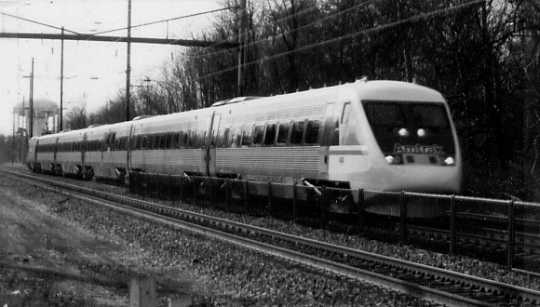
Often, memories seem to grow over the years. Thirty years ago, the Pennsylvania
Railroad renovated some of their old P70 coaches for use to accommodate
the expected crowds attending the New York World's Fair. Those heavyweight
class P70fbr's seemed to glide along the rails. I don't believe that I
ever had a better ride!
Then came the Fleet. (Amfleet, that is!) For all the hoopla, they were
underweight MU trailers (pulled by E60 freight motors) with small windows
and too many seats. After all, Amtrak was just marking time, transporting
people from Point A to Point B, just waiting for the inevitable demise
of nationwide passenger trains.
Every time I would careen up or down the Northeast corridor in the ubiquitous
Amfleet, it seemed to me that perhaps my recollection was exaggerated -
nothing could EVER ride as well as I thought the P70fbr's rode!
But on Saturday, March 20th, 1993, I had the opportunity to ride the
much-touted tilting and radial truck-equipped X2000.
As a wheelchair rider, I was curious to sample the accessibility of
the Swedish equipment. I was delighted to see the wheelchair lifts in the
cab car for low-level platforms. Accessibility was every bit as good as
Amfleet and better.
Much has already been written of the all-first-class configuration of
the train. (I imagine that it will also have coach, if Amtrak buys it.)
Each seat has the usual lighting control, as well as a jack for a stereo
headset (rent one, or bring your own).
As is often the case, speed is deceptive. It didn't seem like 135 MPH
through Middle River, or taking curves at 25 to 30 MPH above normal, but
that is what the public address announcer said. And if that weren't enough,
the end bulkhead has a variable message scroll that gives time, speed,
station announcements - and advertises the Bistro car.
The tilting operation was unobtrusive, and the ride was fantastic! I
didn't even need the brake on in my wheelchair for the trip to Philadelphia,
and I can tell you that the X2000 rides better at 135 than any Amfleet
car does at 35. (I know - I had to endure an Amcafe on my return trip.)
And my memories? Now I know the P70fbr DID glide over the rails.
My advice to Amtrak: Reequip the corridors with X2000's. Banish Amfleet
(and Horizon fleet) to commuter service. NOW!
Big Snow in the West Virginia Panhandle
[By Allen Brougham] . . .
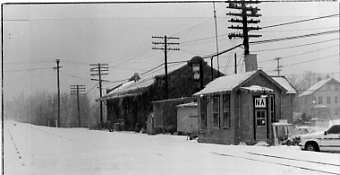
They called it the Blizzard of the Century. The snow storm of March
13, 1993, came exactly 105 years from the date of a storm called the blizzard
of the last century. Everyone in the eastern part of the United States
and Canada caught in this one has a particular story to tell. Here's mine:
- SATURDAY. I would normally be spending this day in a pleasant
afternoon and evening of duty at Miller Tower, which is tucked away in
the splendor of West Virginia's Eastern Panhandle. It's not the sort of
place to try getting to in a mammoth blizzard... but more on this later.
I had spent the night in a motel near Martinsburg, about 10 miles from
the tower, as I did not wish to tackle my usual 107-mile drive from home
after hearing the forecast given the day before. As Saturday afternoon
approached, the hilly back roads from Martinsburg to Miller had long become
impassable. So I got myself a couple of miles to NA Tower in downtown Martinsburg
where I had been offered the thrill of a helper engine ride from there
to Miller. But on arrival at NA Tower I learned that the relieving operator
for that location could not get in... So I sort of got drafted to perform
duties there instead. A couple of moves were made. But Amtrak's westbound
Capitol Limited, which serves Martinsburg, was annulled. Then they decided
to shut our part of the railroad down. It was still snowing hard, and I
got stuck twice getting out, but I managed to make it back to the motel.
- SUNDAY. The snow had stopped, but there were high winds and
heavy drifting. Almost everything was closed, including the railroad, but
they needed me that afternoon back at NA Tower - if I could get in. I did.
All roads in West Virginia were officially closed by order of the governor,
but the order was not enforced on the main streets if you could get through.
Two trains were run - lite engines in each direction to clear drifts, fallen
limbs, etc. Later that evening I made it back to the motel.
- MONDAY. It's usually my day off, but I was needed at Miller.
The back roads were still impassable, so I rode a switcher - B775 - from
NA Tower to Miller. Thrill! We went the low-grade line from West Cumbo,
this being the first move on that track since the storm. There were no
trees down, but we did cut through some pretty mean drifts. A number of
trains were running, including the Capitol Limited, its first westbound
trip since Friday, and (Thrill, again!) I got back to NA Tower that night
on L141, a trailer train being rerouted because of the storm.
My own experience through the so-called Blizzard of the Century was
scarcely what could be called a hardship. Conveniently quartered only a
couple of miles from downtown, I was able to protect my assignment with
little difficulty. In fact, much of the time during the storm and its aftermath
I spent enjoying the comfort of my motel room, from which I could watch
the snow, or TV, and ponder things to write about. Cabin fever was my biggest
complaint.
But not all were so fortunate. One of the operators had to spend most
of two days and one night in his tower after his car's clutch failed in
the snow. Others were called upon to work unassigned hours to cover vacancies,
and some couldn't get to work at all.
It's all history now, and something for all to remember in our own particular
way. But one word to the wise whenever snow is imminent: Always carry a
snow shovel!
'Leapfrogging' on Amtrak
[By Allen Brougham] . . .
Have you ever entertained the dream of a long-distance trip by Amtrak,
complete with the amenities of first-class sleeping car travel, only to
be scared off by the price of a ticket? Most will agree that Amtrak's basic
coach fares are not unreasonable, but travel by first-class can often more
than triple the cost of a long-distance trip.
So if you fall into the category of one who seeks economy, but would
still like to enjoy the comfort of night-time sleeping car travel, then
here is an idea you just might want to consider.
Leapfrogging is a concept that comprehends the use of a sleeper only
during night-time hours. During the day, when lesser-priced coach travel
is deemed sufficient, the sleeping space gets vacated. The concept works
best when there are a lot of day-time travel hours involved, either before
or after at least one night of travel.
One veteran Amtrak traveler who has made effective use of leapfrogging
in the past is Gordy Bjoraker. Gordy, who makes about four long-distance
trips a year, advises that leapfrogging can save money, but not
always. You have to know how Amtrak's tariffs work, he says, and the
nuisance of moving one's luggage during the course of a trip might not
be worth the savings.
Another factor to be considered is the value of meals, which are free
to sleeping car passengers but not to those riding coach. To this end,
it is advisable to structure any leapfrogging in order for sleeping car
hours and dinner/breakfast hours to overlap. Lunch, if desired, would have
to be paid for by the leapfrogger - who would probably then be riding coach
- but the cost of lunch might easily be absorbed by whatever greater savings
are realized by leapfrogging.
The concept may appear simple, but those choosing to try leapfrogging
are best advised to carefully examine Amtrak's accommodation charges all
along the route involved to determine best value. It is sometimes the case
that an accommodation charge to one possible leapfrogging point is actually
the same to an even more distant point. Or there might not even be any
savings at all. Each particular itinerary should be evaluated on its own
merits.
Alan Crumbaker, Pete Sprusby and Joe Shlabotnik each spent a number
of hours last month looking through Amtrak's tariffs to produce a list
of leapfrog savings possible for selected intermediate and end points.
For the list, which is included below, they incorporated the basic guideline
of at least occupying sleeping car space beginning at the stop at or before
8PM, and ending at the stop at or after 8AM. This was done in order to
capture dinner and breakfast hours along with a full night of sleep. But
if the sleeping car space charge under this guideline was found to be the
same over an even greater distance, then use of the sleeping space over
that greater distance prevails. Also, if the cost for sleeping car space
between guidelined leapfrogging points was found to be no more than $5
compared to the cost for that space from or to one of the selected end
points, then use of the sleeping space over that greater distance from
or to the end point prevails.
Sleeping car space charges shown represent individual one-person travel
in either a roomette or an economy bedroom - whichever is offered - and
is quoted exclusive of the basic rail fare. Since the basic rail fare applies
whether sleeping car space is used or not, that fare will not affect the
bottom-line savings shown for leapfrogging. Still, you should be aware
that sleeping car space charges are always in addition to the basic
rail fare.
The list shows the cost of sleeping car space between selected trip
end points (line A), the cost for shortened use of that space as a part
of leapfrogging (line B), and the savings realized therefrom (line C).
The selected trip end points in line A may or may not be the extreme distant
end points for the train involved. Space charges quoted are those that
were in effect in March 1993 do not include any short-term accommodation
discounts that Amtrak may occasionally allow, and are subject to change.
There is no assurance that leapfrogging will offer similar savings in the
future.
One final word of caution if you want to try leapfrogging: Be sure to
tell the conductor what you are doing prior to arriving at a change-in-accommodation
location. There might be a logistical problem, particularly if you will
be moving from a car near the rear of the train to a car near the front.
Some stations have short platforms and no scheduled dwell time. A worst
case scenario might find the leapfrogger disembark, and then have the train
leave before the leapfrogger could get back on. The conductor might recommend
that the transfer be made aboard the train rather than along the platform.
LIST OF LEAPFROGGING SAVINGS POSSIBILITIES -- CLICK HERE
Slumbercoach fares are not included. Slumbercoach space charges are
generally the same regardless of distance traveled.
Fares quoted are those in effect in March 1993. There is no assurance
that leapfrogging will offer similar savings in the future.
Sonny Clodfelter Retires
[By Allen Brougham] . . .
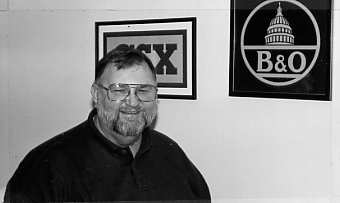
Veteran B&O operator and agent Hoy Derwood Clodfelter retired on
March 12 after over 41 years of railroad service. His nickname of Sonny
has been with him since about the age of seven, and it is by that name
that he was known throughout his career.
Sonny started on the railroad in December of 1951 as a leverman at CX
Tower in Baltimore. He also worked as a leverman at nearby Lee Street before
advancing to the position of operator. His first operator's assignment
was at BX Tower near Baltimore's Curtis Bay yard, and he also worked extra
operator positions in the Baltimore area at Westport, Waverly, Riverside
and Bay View.
His first regular job was the midnight position at A Tower in Aberdeen,
Maryland, to and from which he usually traveled by train.
In September of 1963 Sonny took a regular roving-relief position which
involved his
going to different assigned locations each day of his work week. Also
called a "Rabbit Turn" because the operator would literally hop
from place to place, it involved offices distantly spaced from JD Tower
in Hyattsville, Maryland, to WJ Tower in Wilmington, Delaware. In 1967
the trek to Wilmington was eliminated and substituted instead by a day
at QN Tower in Washington, D.C. In addition to QN and JD, Sonny saw duty
each week at BX Tower, Riverside and Bay View. It still involved a lot
of travel, and there was no one office to which Sonny could call "home,"
but the roving-relief job provided him with a great deal of variety which
he enjoyed.
Then, in 1983, upon the retirement of Arthur Vance, Sonny took the daylight
position at Bay View. He now had a place to call "home," and
it also was a job in which he could enjoy having both Saturday and Sunday
off. When Bay View closed in 1984, Sonny was the operator on duty who closed
it.
He then took a position as a freight loss and damage inspector. Later,
in 1990, he became a ticket agent at the MARC commuter station at Odenton,
Maryland, and held that position until he retired.
Although Sonny held no further tower positions after 1984, he did maintain
qualification as an operator and was often called upon to work weekend
and holiday vacancies at towers he had formerly served that were still
open. All have since closed, but his duty at those places while they were
open kept an uplifting spirit among the younger operators who looked upon
Sonny as an elder statesman within their ranks.
Until 1984 Sonny worked exclusively in the towers. But on a couple of
occasions in the early part of his career he did get called upon to substitute
as a freight agent when nobody else was available. Not being a qualified
agent, he could do little more than distribute paychecks and answer the
phone. If a complex matter developed, he would try to satisfy the situation
as best he could. On one such occasion, while at Mount Airy, Maryland,
someone called Sonny to ask how much it would cost to ship about 60 sheep
to California. It was actually a gag perpetrated by Tom Landers, one of
Sonny's co-workers, but it caused Sonny some anxious moments while he attempted
to serve the inquiry. He and Tom still laugh about it.
Some more anxious moments occurred during Sonny's tenure at A Tower.
It seems he once dozed off and caused a hotshot westbound freight to get
stopped. It was No. 91, which had only recently been elevated to priority
status, and Sonny knew that delays to it would not be looked upon lightly.
He quickly gave the train the signal, and then reported the train passing
the tower with a slightly "fudged" time in the hope that this
might obscure the train having been stopped. In turn, he asked Ralph Fisher
at Poplar Tower, the next tower to the west, if he could fudge his time
as well. Ralph agreed. But when Ralph reported the train by his station
just 23 minutes later, a rather fast run, Sonny called Ralph to say: "Thanks,
but you didn't have to fudge the time by THAT much!" Ralph replied
by saying that he hadn't fudged the time at all . . . The train had made
a fast enough run to more than cover up Sonny's nap-incurred delay.
Sonny says his career with the railroad has been tremendously rewarding.
Given the opportunity, he would do it all over again.
He and his wife live in Pasadena, Maryland.
'Railroad Rob' Gets CSXT Commendation
[By Allen Brougham] . . .
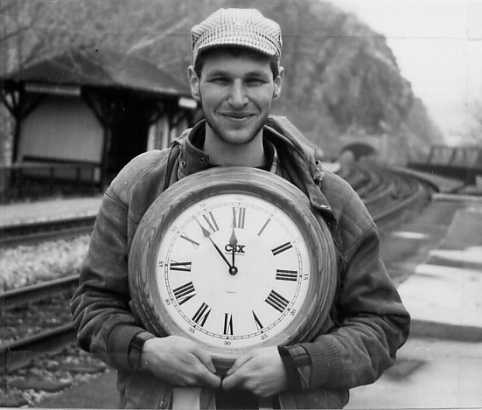
Robbie Brzostowski, the railfan from Harpers Ferry, West Virginia, who
was featured in last month's issue of the Bull Sheet, has been commended
by CSXT for his alertness that may have prevented an accident.
A letter he received from Bill Minnick, superintendent of the Baltimore
Division, tells it all:
"I have been advised that on the evening of Wednesday, February
10, 1993, you discovered a substantial gap in the rail on our main track
just east of Harpers Ferry station and reported it to the CSX agent.
"After being advised of the defect, our track forces promptly responded
and corrected the problem.
"Your prompt action as a concerned citizen may have prevented a
serious accident from occurring.
"We would like to recognize you for your actions by presenting
you with the enclosed CSX wall clock as a token of our appreciation.
"Again, many thanks for your assistance."
Robbie is shown in the photo above, not far from the site of the defect
he discovered, holding his gift.
Preservation Group Meets to Discuss JD Tower
CSX Transportation has offered to sell JD Tower to the city of Hyattsville,
Maryland, for one dollar, provided the city agrees to move the structure
from railroad property.
At a meeting of the Hyattsville Preservation Association on March 9,
the topic was the tower and its possible use. About 30 people attended,
and copies of the April 1992 issue of the Bull
Sheet, which featured JD Tower, were distributed to members.
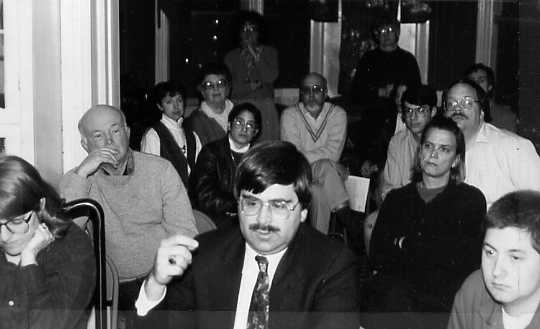
In the photo above, Vince Cipriani (center), an instructor at Prince
George's Community College, is shown speaking on the history of the tower
and explaining its function.
JD Tower closed March 5, 1992.
CSXT Changes Approach Signal Rule
The rule applying to action taken when encountering an Approach signal
has been changed on the former Seaboard and Chessie portions of CSXT.
- Former rule: Proceed prepared to stop at next signal.
- New rule: Proceed prepared to stop at next signal. Trains exceeding
medium speed must immediately begin reduction to medium speed as soon as
the engine passes the approach signal.
Medium speed is defined as one not exceeding 30 miles per hour.
The Approach aspect on the former Seaboard is yellow, or yellow over
red, or yellow over red over red. On both the former C&O and Western
Maryland, it is yellow, or yellow over red. On the former B&O, the
color-position signal is white over two diagonal yellows. On the former
RF&P, where a separate rule regarding the Approach signal is already
in use, the aspect is yellow, or yellow over red, or yellow over red over
red.
CSXT Opens New Repair Shop in Richmond
CSX Transportation has begun transferring employees to its new $3-million
work equipment repair facility at the Bryant Park Shops complex in Richmond,
Virginia. The 85,000-square-foot facility, expected to be fully operational
May 1, will employ approximately 140 people. Most of them will be coming
from shops in Hamlet, North Carolina; Fairmont, West Virginia; Waycross,
Georgia; and Columbus, Ohio. The new shop, located on the site of the old
RF&P car and locomotive shop, will concentrate on the repair and servicing
of heavy equipment for track work.
According to the CSX Employee News Service, the work equipment repair
shops at Hamlet and Fairmont will be closed, and those at Waycross and
Columbus will be scaled back to light repairs.
Some B&O Baltimore Division Conductor & Engineer
Names From 1951
CLICK HERE
Germantown, Maryland, Derailment Disrupts Amtrak, Commuter
Traffic
A major freight train derailment the evening of March 23, 1993, near
Germantown, Maryland, closed both tracks of CSXT's Metropolitan Subdivision
and caused disruption to Amtrak's Capitol Limited and MARC commuter service.
The Capitol Limited in each direction was rerouted by way of Amtrak's
Northeast Corridor and Conrail through Philadelphia and Harrisburg March
24 and 25, and the eastbound Capitol Limited was also rerouted March 26.
Brunswick Line MARC service was maintained with commuters being bused
around the derailment for two days. MARC trains resumed on March 26, but
with minor delays passing the accident site.
The derailment involved an 80-car eastbound train loaded mostly with
new automobiles and vans. There were no injuries.
New SD70M Locomotives Being Tested on Conrail
General Motors SD70M demonstrator units are currently being tested on
Conrail. They are slated to be tested out of Harrisburg beginning about
April 7. They will then reportedly be tested on CSXT out of Cumberland,
Maryland, beginning about the middle of the month.
Baltimore Light-Rail Extension to Open
Extension of Baltimore light-rail service south from Patapsco Avenue
to Linthicum begins April 2, 1993, for Orioles games. Regular service is
slated to begin later in the month.
'MARC to the Park' Specials to be Offered
MARC To The Park baseball specials will be offered to all home Orioles
games this season, but specials from and to the Brunswick line have been
eliminated. Virginia Railway Express may operate some specials from Virginia
on an experimental basis, but plans for these are not definite.
Norfolk Southern to Locate Customer Service Center in Atlanta
Norfolk Southern has announced that its new system-wide customer service
center will be located in Atlanta, Georgia. It is expected to be fully
staffed and operational by December, 1993.
CSXT Retires Last of its GP16 Locomotives
CSXT has retired the remainder of its GP16 locomotives.
Oscar Churn Dies
Oscar Churn, retired B&O Baltimore Division interlocking tower operator,
died March 25, 1993. He was 81.
.




